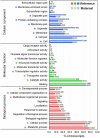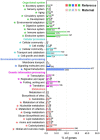Transcriptome Analysis of Maternal Gene Transcripts in Unfertilized Eggs of Misgurnus anguillicaudatus and Identification of Immune-Related Maternal Genes
- PMID: 32485896
- PMCID: PMC7312655
- DOI: 10.3390/ijms21113872
Transcriptome Analysis of Maternal Gene Transcripts in Unfertilized Eggs of Misgurnus anguillicaudatus and Identification of Immune-Related Maternal Genes
Abstract
Maternal genes are important in directing early development and determining egg quality in fish. We here report the de novo transcriptome from four tissue libraries of the cyprinid loach, Misgurnus anguillicaudatus, and for the first time identified maternal gene transcripts in unfertilized eggs and suggest their immune system involvement. Expression profiles and functional enrichment revealed a total 24,116 transcripts were expressed as maternal transcripts in unfertilized eggs, which were involved in a wide range of biological functions and pathways. Comparison expression profiles and analysis of tissue specificity revealed that the large numbers of maternal transcripts were stored in unfertilized eggs near the late phase of ovarian maturation and before ovulation. Functional classification showed a total of 279 maternal immune-related transcripts classified with immune system process GO term and immune system KEGG pathway. qPCR analysis showed that transcript levels of identified maternal immune-related candidate genes were dynamically modulated during development and early ontogeny of M. anguillicaudatus. Taken together, this study could not only provide knowledge on the protective roles of maternal immune-related genes during early life stage of M. anguillicaudatus but could also be a valuable transcriptomic/genomic resource for further analysis of maternally provisioned genes in M. anguillicaudatus and other related teleost fishes.
Keywords: Misgurnus anguillicaudatus; de novo transcriptome; immune-related gene; maternal gene transcript; unfertilized egg.
Conflict of interest statement
The authors declare no conflict of interest.
Figures






Similar articles
-
De novo assembly of mud loach (Misgurnus anguillicaudatus) skin transcriptome to identify putative genes involved in immunity and epidermal mucus secretion.PLoS One. 2013;8(2):e56998. doi: 10.1371/journal.pone.0056998. Epub 2013 Feb 20. PLoS One. 2013. PMID: 23437293 Free PMC article.
-
Developmental transcriptome analysis and identification of genes involved in formation of intestinal air-breathing function of Dojo loach, Misgurnus anguillicaudatus.Sci Rep. 2016 Aug 22;6:31845. doi: 10.1038/srep31845. Sci Rep. 2016. PMID: 27545457 Free PMC article.
-
Full-length transcriptome of Misgurnus anguillicaudatus provides insights into evolution of genus Misgurnus.Sci Rep. 2018 Aug 3;8(1):11699. doi: 10.1038/s41598-018-29991-6. Sci Rep. 2018. PMID: 30076392 Free PMC article.
-
Transcriptomic Analysis of Compromise Between Air-Breathing and Nutrient Uptake of Posterior Intestine in Loach (Misgurnus anguillicaudatus), an Air-Breathing Fish.Mar Biotechnol (NY). 2016 Aug;18(4):521-33. doi: 10.1007/s10126-016-9713-9. Epub 2016 Jul 25. Mar Biotechnol (NY). 2016. PMID: 27457889
-
Genomic constitution and atypical reproduction in polyploid and unisexual lineages of the Misgurnus loach, a teleost fish.Cytogenet Genome Res. 2013;140(2-4):226-40. doi: 10.1159/000353301. Epub 2013 Jul 9. Cytogenet Genome Res. 2013. PMID: 23899809 Review.
Cited by
-
Comparative transcriptome profiles of four sexually size dimorphic fish.Sci Data. 2022 Dec 17;9(1):774. doi: 10.1038/s41597-022-01887-1. Sci Data. 2022. PMID: 36528628 Free PMC article.
-
Nano‑zinc enhances gene regulation of non‑specific immunity and antioxidative status to mitigate multiple stresses in fish.Sci Rep. 2023 Mar 28;13(1):5015. doi: 10.1038/s41598-023-32296-y. Sci Rep. 2023. PMID: 36977939 Free PMC article.
-
Developmental series of gene expression clarifies maternal mRNA provisioning and maternal-to-zygotic transition in a reef-building coral.BMC Genomics. 2021 Nov 11;22(1):815. doi: 10.1186/s12864-021-08114-y. BMC Genomics. 2021. PMID: 34763678 Free PMC article.
-
Paternal-effect-genes revealed through sperm cryopreservation in Perca fluviatilis.Sci Rep. 2024 Mar 16;14(1):6396. doi: 10.1038/s41598-024-56971-w. Sci Rep. 2024. PMID: 38493223 Free PMC article.
References
-
- Bowerman B. Maternal control of pattern formation in early Caenorhabditis elegans embryos. Curr. Top. Dev. Biol. 1998;39:73–117. - PubMed
MeSH terms
Substances
LinkOut - more resources
Full Text Sources

